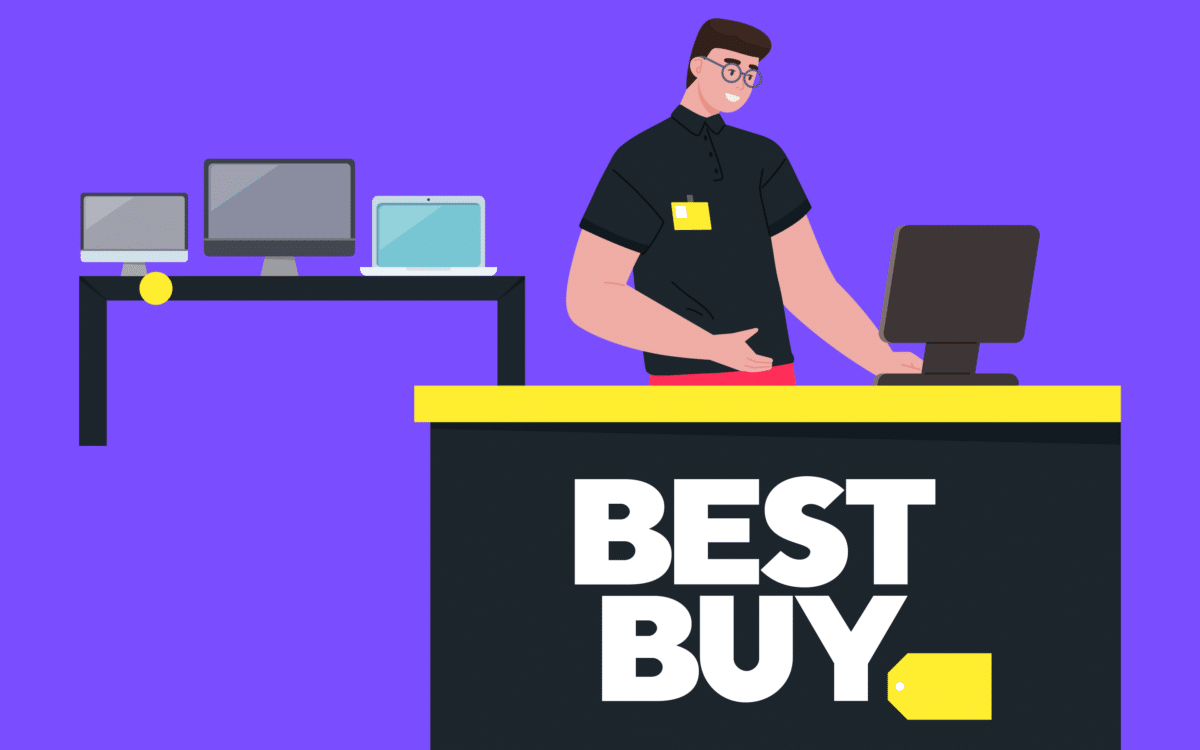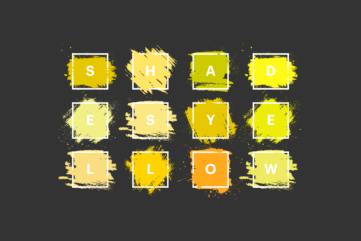Yellow branding: What does yellow signify in branding?

What does yellow signify in branding, and how do you know if a yellow color palette is right for your company?
At a glance, a yellow brand might seem like the perfect way to grab customer attention in a cluttered and competitive marketplace. After all, yellow is naturally vivid, vibrant, and engaging.
As the most visible color in the spectrum, our eyes are naturally drawn to yellow shades. There’s a reason why construction workers wear yellow when working in messy sites and why safety professionals use yellow hazard signs to warn people of impending danger.
When we see something yellow, our brains are programmed to pay attention.
However, choosing the right color palette for your brand is about more than just making your logo and advertising materials as “visible” as possible.
Every color conveys a specific message to your audience, evoking certain emotions and feelings that can alter the relationship you build with your customers.
So, what does yellow say about your brand?
What does yellow say about your brand?
Available in a variety of shades, ranging from mustard and gold to zesty lemon hues, yellow is a relatively versatile shade. Although most yellows are associated with happiness, joy, and enlightenment, the exact pigment you pick for your brand can alter how your customers see you.
For instance, golden yellow tones are more likely to make your company appear luxurious and opulent, while dark yellow hues are earthy and sophisticated. Pale yellows are relaxing and soothing, often associated with concepts like spring and summer, while warm orange yellows inspire creativity.
Studies into yellow brands have given us some interesting insights into how this color influences purchasing decisions.
According to one study, yellow shades are less likely to be associated with quality, reliability, and courage. However, they are more likely to be connected with concepts like fun, frugality, speed, and trust.
In other words, using yellow for branding might be ideal if you want to align your business with concepts like convenience, budget-friendly prices, and unique experiences.
Alternatively, if you want to be seen as courageous and reliable, you might be better off opting for shades like red, blue, orange, or black and white.

Using yellow for branding: Positive and negative associations
Like many shades assessed in color psychology, yellow can invoke different emotions in different people, contexts, and situations.
Yellow is often considered a “mood enhancer,” which means it can make people feel happier if they’re already in a good mood or angrier and more agitated if they’re feeling negative already. This hue is also an extremely energetic shade.
Yellow can increase cognitive focus, and inspire action, making it ideal for customers who want to engage their audience.
However, high doses of yellow can also be frustrating and stressful. Particularly bright tones are visually exhausting after a while and may be seen as abrasive or egotistical.
When answering the question, “what does yellow signify in branding” it’s worth looking at both sides of the coin: the positive and the negative associations.
From a positive perspective, yellow is often connected with:
- Joy: Yellow is the color of the sun, and it’s often seen as a bright and happy hue, particularly among younger audiences. Yellow colors can make us smile and laugh.
- Energy: As a highly vivid and engaging color, yellow can inspire action, promote deeper thought, and even motivate us when we feel lethargic.
- Enlightenment: Yellow is a highly spiritual color in some cultures, connected with wisdom, self-awareness, and knowledge.
- Focus: Yellow can actually improve our cognitive functioning in some cases. It engages the left side of the brain, which supports critical thinking.
- Creativity: Many people see yellow as a creative, out-of-the-box color, great for grabbing attention and separating brands from the competition.
On the other hand, yellow can also be:
- Abrasive: A high-energy color like yellow can be visually exhausting in large doses, particularly when you choose a bright hue.
- Sickly: Some shades of yellow are associated with toxicity, illness, and general sickness. Be careful combining yellow and green in particular.
- Frustrating: Yellow is the least favorite color of many people around the world. It can make people feel agitated and frustrated in some cases.
Yellow is also associated with negative concepts in some parts of the world. For instance, being “yellow-bellied” is a term connected with cowardice.
Is yellow right for your brand? Questions to ask
So, how do you decide if yellow branding is right for your company?
Ultimately, there’s no simple strategy for choosing the ideal color palette. Companies need to consider their brand objectives and target audience carefully. Here are some questions to ask if you’re thinking of using yellow for branding purposes:
Who is my target audience?
What kind of colors are your target audience already attracted to? Are you targeting youthful go-getters or spiritual people? If so, yellow might be a great option, as yellow is usually more appealing to young consumers.
What are the components of my brand personality?
How do you want people to perceive your brand? Do you want to come across as fun and playful? Then, yellow might be a good choice. However, it’s not a good option if you want to be seen as luxurious and reliable.
Who is my competition?
Checking out the competition can be a good way to see whether other companies already benefit from using yellow in their branding. If this is the first time anyone else is using yellow in your industry, ask why this might be.
What other colors will I be using?
Most brand color palettes feature a handful of colors. What shades are you planning on using alongside yellow? How can you ensure your chosen collection isn’t too visually overwhelming?
How will I be using yellow in my brand?
Is yellow going to be the core color of your brand logo or your website, or are you going to be using it as an accent shade? Yellow can be abrasive in large doses, so it’s best used sparingly.
Examples of brands using yellow: Famous yellow brands
There are examples of yellow branding all over the world today.
You’re probably already familiar with the yellow Snapchat logo or the bright yellow background in the Ferrari logo. If you’ve ever seen a DHL van, you’ll know they’re usually decked out in yellow too. Even companies like Nesquik use yellow in their packaging.
One thing you may notice when looking for examples of yellow brands is that many of them appear in the food and beverage industry. There’s a reason why McDonald’s has its golden arches and Denny’s has that yellow banner.
Simply put, colors like yellow, red, and orange are excellent for activating the metabolism and making people feel hungry.
The color yellow also stands out well on store shelves, so it can be a great option if you’re trying to capture your customer’s attention in a busy supermarket. Some other great examples of companies with yellow branding include:

Stanley
The Stanley logo takes advantage of yellow’s existing connotations with the construction market. The deep shade of yellow is sophisticated and engaging. It gives customers an insight into the industry Stanley belongs to.

National Geographic
As mentioned above, yellow can often be associated with enlightenment. It’s also strongly connected with the natural world.
The sun, countless flowers, and various fruits and vegetables are all yellow. It makes sense for a company focused on the natural world and education like Nat Geo to use yellow in its branding.

Best Buy
Many people associate the color yellow with frugality and discounts. We often see yellow labels on sale items designed to grab our attention. Best Buy uses an accent of yellow in its logo to tell customers they’ll be getting a great deal.
Is yellow a good color to use for branding?
So, what does yellow signify in branding? That’s a question with many possible answers.
It could be an amazing way to tell your audience that you’re committed to budget-friendly pricing or creativity. It could also be a fantastic tool for engaging your younger target audience and showing your playful side. However, yellow can have a lot of negative connotations too.
When using yellow in branding, it’s worth being extra cautious. Bright shades like yellow can easily overwhelm the eye and drown out your marketing message if you need to be more careful. It might be worth working with a branding professional if you’re planning to create your own yellow brand.
They’ll be able to advise you on how to use yellow effectively without overwhelming your target audience. Good luck building your yellow brand.
Fabrik: A branding agency for our times.
Now read these:
—Your guide to colors that complement yellow
—The ultimate guide to the many shades of yellow
—How to make yellow and create the perfect mix
—Your guide to using yellow in packaging design
—The psychology of yellow and what it represents
—Should you choose yellow for logo design?
—Exploring the colors of the rainbow
















